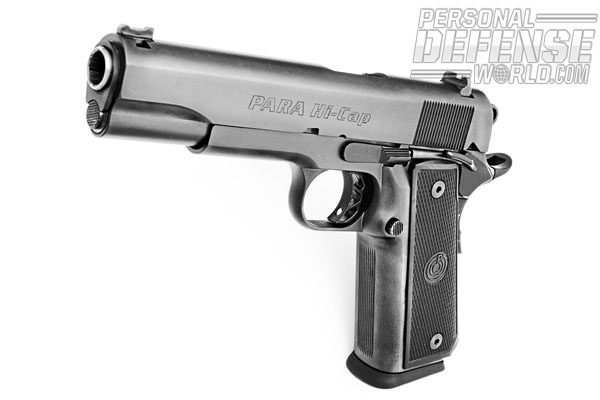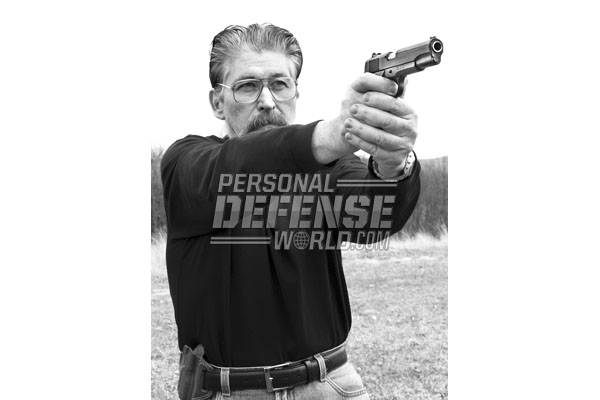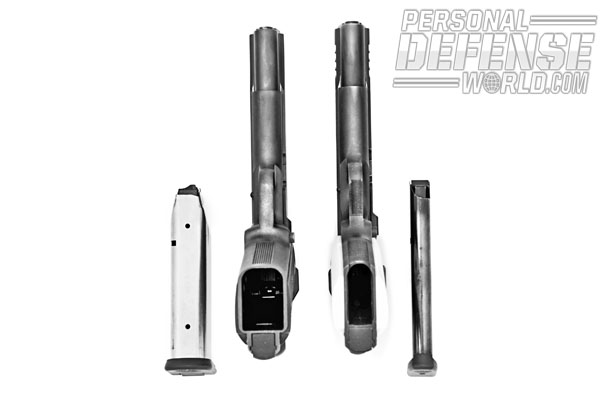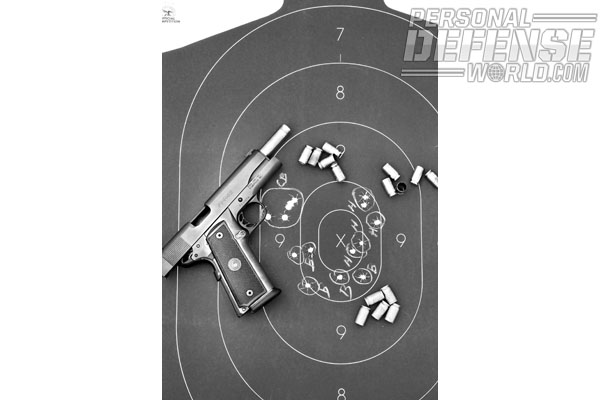Para USA has been manufacturing its improved Model 1911A1 semi-automatics for almost a quarter of a century and each year their guns get more innovative, with variations designed for competition, law enforcement, and compact carry. In 2011, however, the company took a step back to pay homage to the gun that started it all in 1988. The Para P14-45 is, with only a few minor improvements, the original Para M1911A1 model that put the arms-making company on a road to success from which it has never veered.
Gun Details
While high-capacity .45 ACP semi-automatics are not uncommon today, the Para was the first production gun to take the 1911 design to the next level. The rest, as they say, is history.
At Para, the guns were always a work in progress and the company was continually developing new ways to improve the 1911. The first major step came in 1990 when Para decided to take the plunge and begin manufacturing the entire gun themselves. Using the basic shape of the proven M1911A1 as a starting point, they created their own version, the original P14-45. The 1911- style frame was rede-signed with built-in plunger tubes and grip bushings. Frame wall thickness around the slide stop hole was made 20 percent greater for extra strength under stress, and the new Para models had a standard ramped barrel with supported chamber; features that were generally expensive options from custom gun-makers. The Para’s double-column tapered magazine also offered more reliable feeding characteristics combined with a beveled magazine well. Other improvements included flaring the ejection port for more reliable operation, a positive slide lock safety, a custom grip safety, and an internal firing pin block. The end result for Para was a 1911 that could feed any type of ammunition—even hollow-points and semi-wadcutters—and take the abuses of competitive shooting or hard use in the field with +P ammunition. It was a 1911 that
could do it all at a price that wasn’t prohibitive. The P14-45 was a benchmark for Para.
Advertisement — Continue Reading Below
The re-introduction of the gun in 2011 featured a tough black Para PK2 finish and superb white-dot rear sight combined with a red fiber optic front sight; otherwise it’s the same gun that made Para famous over 20 years ago. Standard features on the model include a skeletonized competition trigger and hammer, an oversized beavertail safety, extended thumb safety and magazine release, and a ramped, match grade stainless steel barrel with crowned muzzle. Running very close to the original P14-45, this latest version tips the scales at 40.5 ounces empty, and 49.5 ounces with 15 rounds on board, (14+1). With one more round
in the magazine than the original Para model, this heavyweight, full-size .45 is well suited for law enforcement, concealed carry, or home protection.
The only minor disadvantage to the Para is finding a holster that fits the raised fiber optic front sight. Most contoured 1911 rigs are a bit too tight out of the box for the Para, but we did find several abbreviated belt holsters like the Galco Combat Master (CM424) that worked ideally with the P14-45’s dimensions. The holster’s butt-forward cant, open-top design and contoured open bottom and sight channel allowed for ease of draw and re-holstering even with the fiber optic front sight. Considering the carry weight of the Para, this style of belt holster is an excellent choice for concealment, comfort and ease of access. Another belt holster that allowed the P14-45 to draw seamlessly was the original style Bianchi Speed Scabbard designed more than 50 years ago. The new Speed Scabbard from Frontier Gunleather also provided excellent carry and concealment for the Para.
Range Time
The heft of the Para P14-45 is man- sized with the grip frame width and magazine well measuring 7/16ths of an inch wider than a standard M1911A1. Not a bad trade-off for an additional seven rounds in the magazine. For most people, a full-size Government Model is also a better choice for ease of handling and recoil compared to a Commander or compact 1911A1-style pistol, all of which generally prove more demanding. When
you add the cartridge capacity of two standard 1911 magazines in one, the overall advantages of the Para are very clear.
Advertisement — Continue Reading Below
Trigger pull on the test gun averaged 6.9 pounds on a Lyman trigger pull gauge. The competition trigger had a minimum of travel (less than 1/8th of an inch) and quick reset from shot to shot. For medium to large hands the P14-45 is a good fit. The hard rubber grips, which are secured with hex-head screws, have an embossed 1911-style checkering pattern; the wide frontstrap is grooved with nine 2.25-inch long vertical serrations and the backstrap has a course checkered, flat mainspring housing. The wide magazine well and front grip frame also provide a rock steady hold for firing rounds like Hornady Critical Defense 185-grain FTX and CorBon 185-grain DPX +P.
Test ammunition was a mix of Blazer 230-grain FMJ, CorBon .45 ACP +P 185-grain DPX and Hornady Critical Defense 185-grain FTX. The latter is one of the latest developments in defensive ammunition designed to reduce recoil, minimize muzzle flash and provide consistent expansion of the bullet, even through heavy layers of clothing.
Fired from the Para’s match grade, 5-inch barrel the FTX clocked 1,020 feet per second (fps) through the ProChrono chronograph traps, the CorBon 1,125 fps, and the 230- grain FMJ Blazer 850 fps. Tests were fired offhand from 50 feet using a Weaver stance, and at 25 yards from a bench rest.
Advertisement — Continue Reading Below
Best groups averaged 1.2 inches for the Hornady at 50 feet, 1.75 inches for the CorBon and 2.0 inches for Blazer. Stepping back to 25 yards, timed-fire of five rounds resulted in an impressive best group of 1.50 inches for CorBon; 2.75 inches for Hornady, and 3.50 inches with Blazer. The best overall performance came from the hot CorBon DPX. While Blazer is a far less costly ammunition, and good for practice, the Para seems to thrive on hot loads like CorBon. The differences in muzzle flip between the 850 fps 230-grain FMJ and 1,125 fps 185-grain DPX was negligible and the Para was back on target in an instant. This is where the white dot rear and red fiber optic front sights really prove their worth.
Final Notes
The Para P14-45 comes standard with nearly all of the upgrades you would pay a top-notch gunsmith to do. It’s a lot of gun for the money; big in size, big in weight, and where it counts most, big in performance. This classic reconfiguration of John M. Browning’s Model 1911 by Para USA remains as noteworthy today
as it was in 1990. To find out more call 704-930-7600 or visit para-usa.com.
To get this issue, visit /.
Advertisement — Continue Reading Below


























